Page 207 of 573
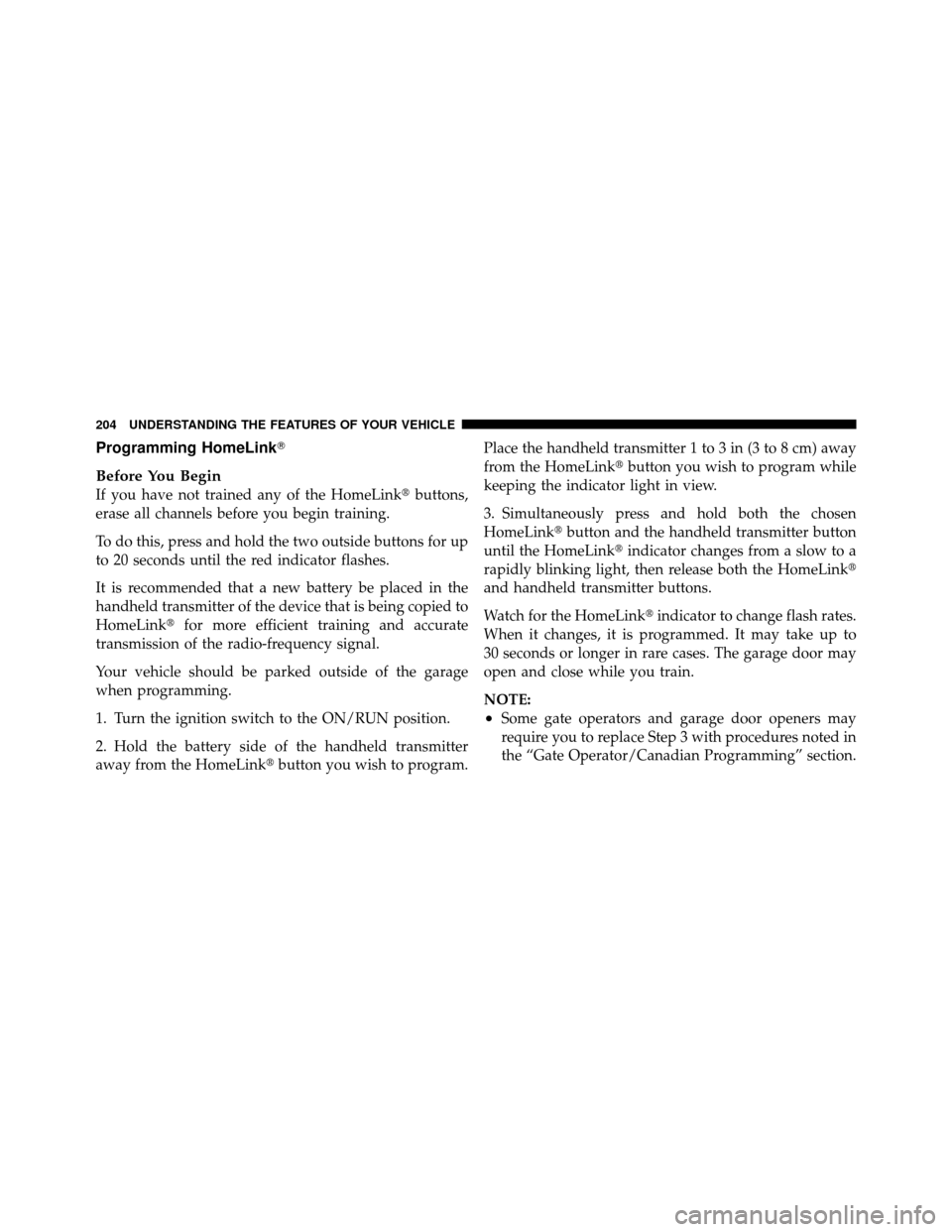
Programming HomeLink�
Before You Begin
If you have not trained any of the HomeLink�buttons,
erase all channels before you begin training.
To do this, press and hold the two outside buttons for up
to 20 seconds until the red indicator flashes.
It is recommended that a new battery be placed in the
handheld transmitter of the device that is being copied to
HomeLink� for more efficient training and accurate
transmission of the radio-frequency signal.
Your vehicle should be parked outside of the garage
when programming.
1. Turn the ignition switch to the ON/RUN position.
2. Hold the battery side of the handheld transmitter
away from the HomeLink� button you wish to program. Place the handheld transmitter 1 to 3 in (3 to 8 cm) away
from the HomeLink�
button you wish to program while
keeping the indicator light in view.
3. Simultaneously press and hold both the chosen
HomeLink� button and the handheld transmitter button
until the HomeLink� indicator changes from a slow to a
rapidly blinking light, then release both the HomeLink�
and handheld transmitter buttons.
Watch for the HomeLink� indicator to change flash rates.
When it changes, it is programmed. It may take up to
30 seconds or longer in rare cases. The garage door may
open and close while you train.
NOTE:
•Some gate operators and garage door openers may
require you to replace Step 3 with procedures noted in
the “Gate Operator/Canadian Programming” section.
204 UNDERSTANDING THE FEATURES OF YOUR VEHICLE
Page 209 of 573
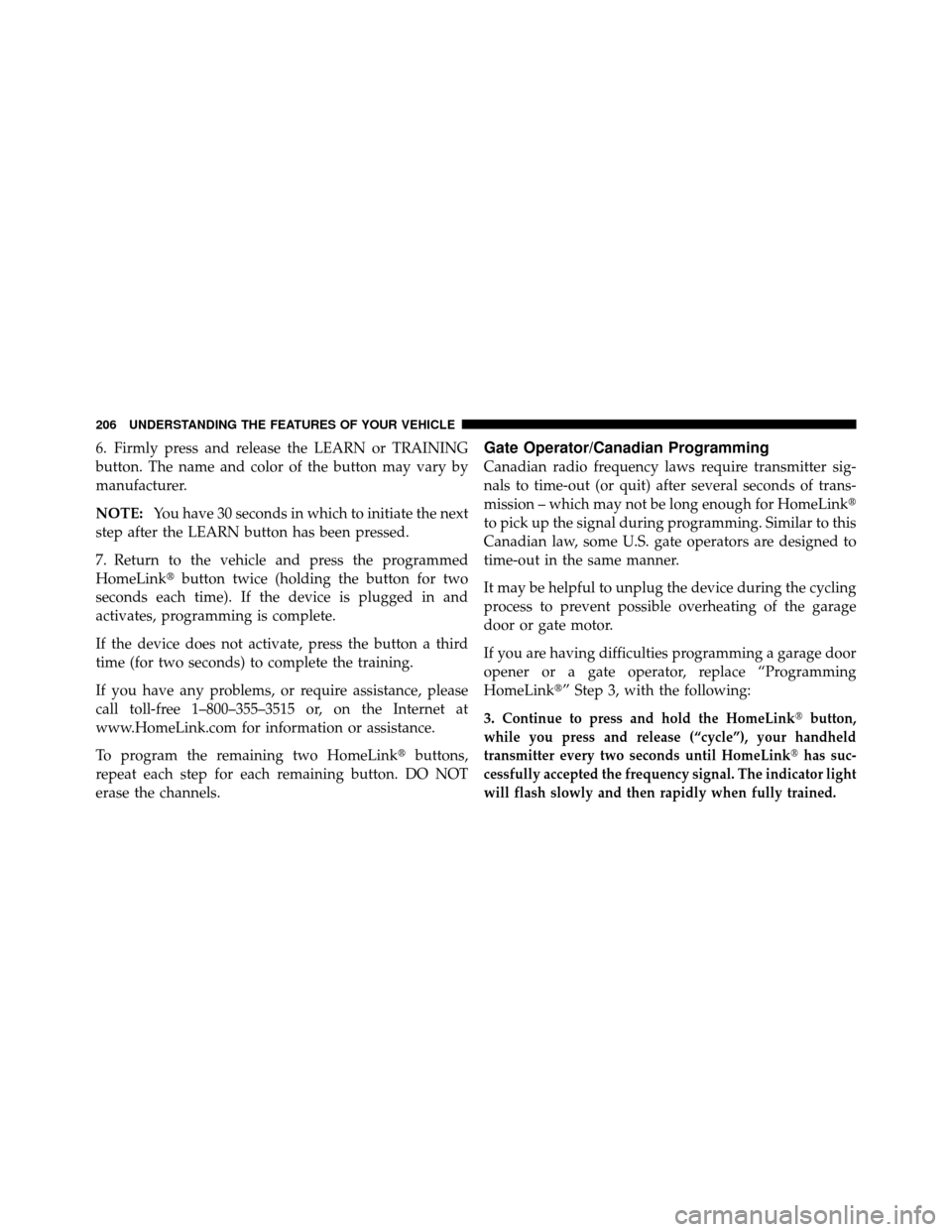
6. Firmly press and release the LEARN or TRAINING
button. The name and color of the button may vary by
manufacturer.
NOTE:You have 30 seconds in which to initiate the next
step after the LEARN button has been pressed.
7. Return to the vehicle and press the programmed
HomeLink� button twice (holding the button for two
seconds each time). If the device is plugged in and
activates, programming is complete.
If the device does not activate, press the button a third
time (for two seconds) to complete the training.
If you have any problems, or require assistance, please
call toll-free 1–800–355–3515 or, on the Internet at
www.HomeLink.com for information or assistance.
To program the remaining two HomeLink� buttons,
repeat each step for each remaining button. DO NOT
erase the channels.Gate Operator/Canadian Programming
Canadian radio frequency laws require transmitter sig-
nals to time-out (or quit) after several seconds of trans-
mission – which may not be long enough for HomeLink�
to pick up the signal during programming. Similar to this
Canadian law, some U.S. gate operators are designed to
time-out in the same manner.
It may be helpful to unplug the device during the cycling
process to prevent possible overheating of the garage
door or gate motor.
If you are having difficulties programming a garage door
opener or a gate operator, replace “Programming
HomeLink�” Step 3, with the following:
3.
Continue to press and hold the HomeLink� button,
while you press and release (“cycle”), your handheld
transmitter every two seconds until HomeLink �has suc-
cessfully accepted the frequency signal. The indicator light
will flash slowly and then rapidly when fully trained.
206 UNDERSTANDING THE FEATURES OF YOUR VEHICLE
Page 251 of 573
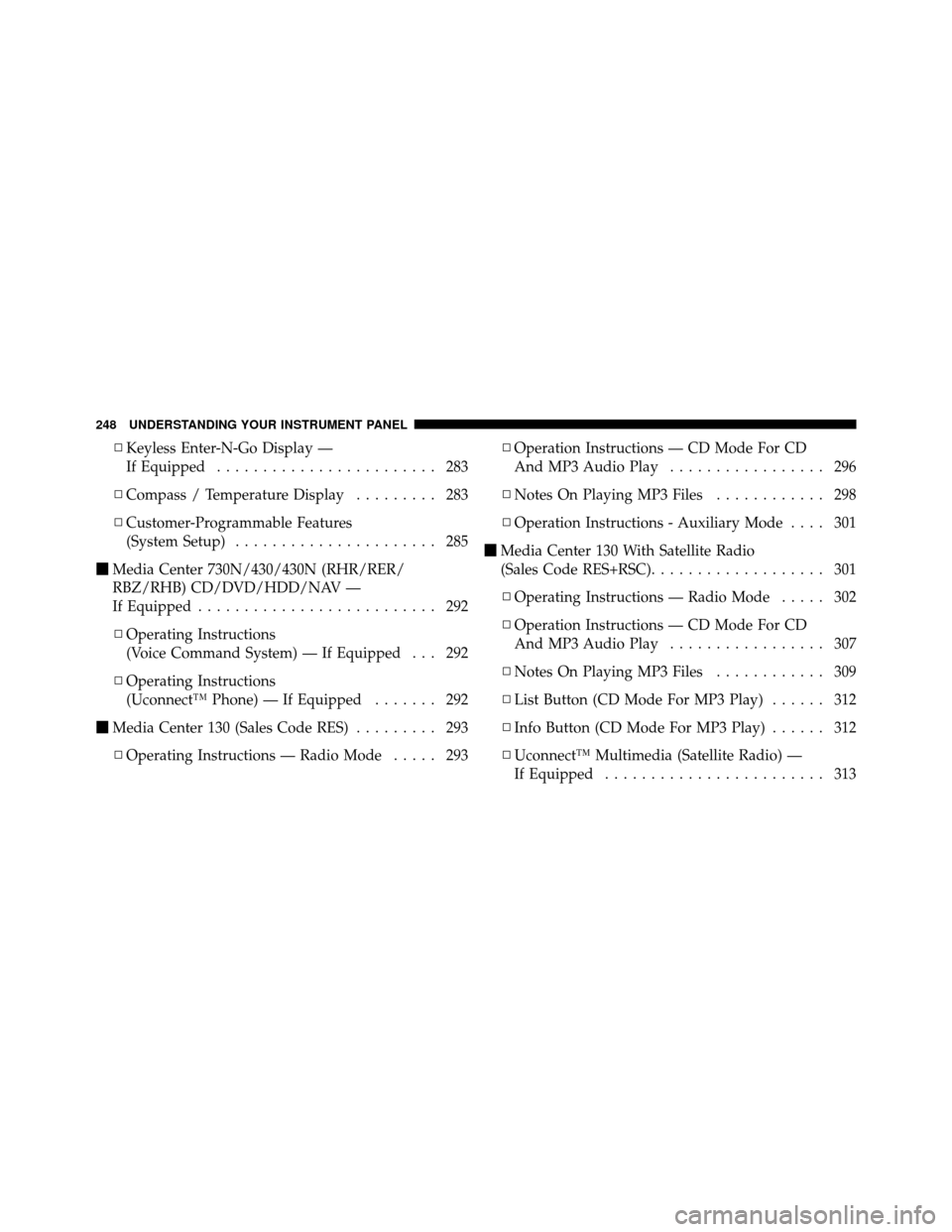
▫Keyless Enter-N-Go Display —
If Equipped ........................ 283
▫ Compass / Temperature Display ......... 283
▫ Customer-Programmable Features
(System Setup) ...................... 285
� Media Center 730N/430/430N (RHR/RER/
RBZ/RHB) CD/DVD/HDD/NAV —
If Equipped .......................... 292
▫ Operating Instructions
(Voice Command System) — If Equipped . . . 292
▫ Operating Instructions
(Uconnect™ Phone) — If Equipped ....... 292
� Media Center 130 (Sales Code RES) ......... 293
▫ Operating Instructions — Radio Mode ..... 293▫
Operation Instructions — CD Mode For CD
And MP3 Audio Play ................. 296
▫ Notes On Playing MP3 Files ............ 298
▫ Operation Instructions - Auxiliary Mode .... 301
� Media Center 130 With Satellite Radio
(Sales Code RES+RSC) ................... 301
▫ Operating Instructions — Radio Mode ..... 302
▫ Operation Instructions — CD Mode For CD
And MP3 Audio Play ................. 307
▫ Notes On Playing MP3 Files ............ 309
▫ List Button (CD Mode For MP3 Play) ...... 312
▫ Info Button (CD Mode For MP3 Play) ...... 312
▫ Uconnect™ Multimedia (Satellite Radio) —
If Equipped ........................ 313
248 UNDERSTANDING YOUR INSTRUMENT PANEL
Page 252 of 573

▫Operating Instructions
(Uconnect™ Phone) — If Equipped ....... 317
� iPod�/USB/MP3 Control — If Equipped ..... 317
▫ Connecting The iPod� Or External USB
Device ............................ 318
▫ Using This Feature ................... 318
▫ Controlling The iPod� Or External USB
Device Using Radio Buttons ............. 319
▫ Play Mode ......................... 319
▫ List Or Browse Mode ................. 321
▫ Bluetooth Streaming Audio (BTSA) ........ 323
� Video Entertainment System (VES)™ —
If Equipped .......................... 324 �
Steering Wheel Audio Controls —
If Equipped .......................... 326
▫ Radio Operation ..................... 327
▫ CD Player ......................... 327
� CD/DVD Disc Maintenance .............. 327
� Radio Operation And Mobile Phones ....... 328
� Climate Controls ...................... 328
▫ Manual Heating And Air Conditioning
System — If Equipped ................. 328
▫ Three-Zone Temperature Control —
If Equipped ........................ 333
▫ Rear Manual Climate Control —
If Equipped ........................ 337
▫ Automatic Temperature Control
(ATC) — If Equipped ................. 340
4
UNDERSTANDING YOUR INSTRUMENT PANEL 249
Page 254 of 573
INSTRUMENT PANEL FEATURES
1 — Air Vents5 — Analog Clock 9 — DVD – If Equipped 13 — Ignition Switch
2 — Instrument Cluster 6 — Upper Glove Compartment 10 — Storage Bin 14 — Hood Release
3 — Shift Lever 7 — Lower Glove Compartment 11 — Cup Holders 15 — Dimmer Switch
4 — Radio 8 — Climate Controls 12 — Switch Bank16 — Headlight Switch
4
UNDERSTANDING YOUR INSTRUMENT PANEL 251
Page 260 of 573
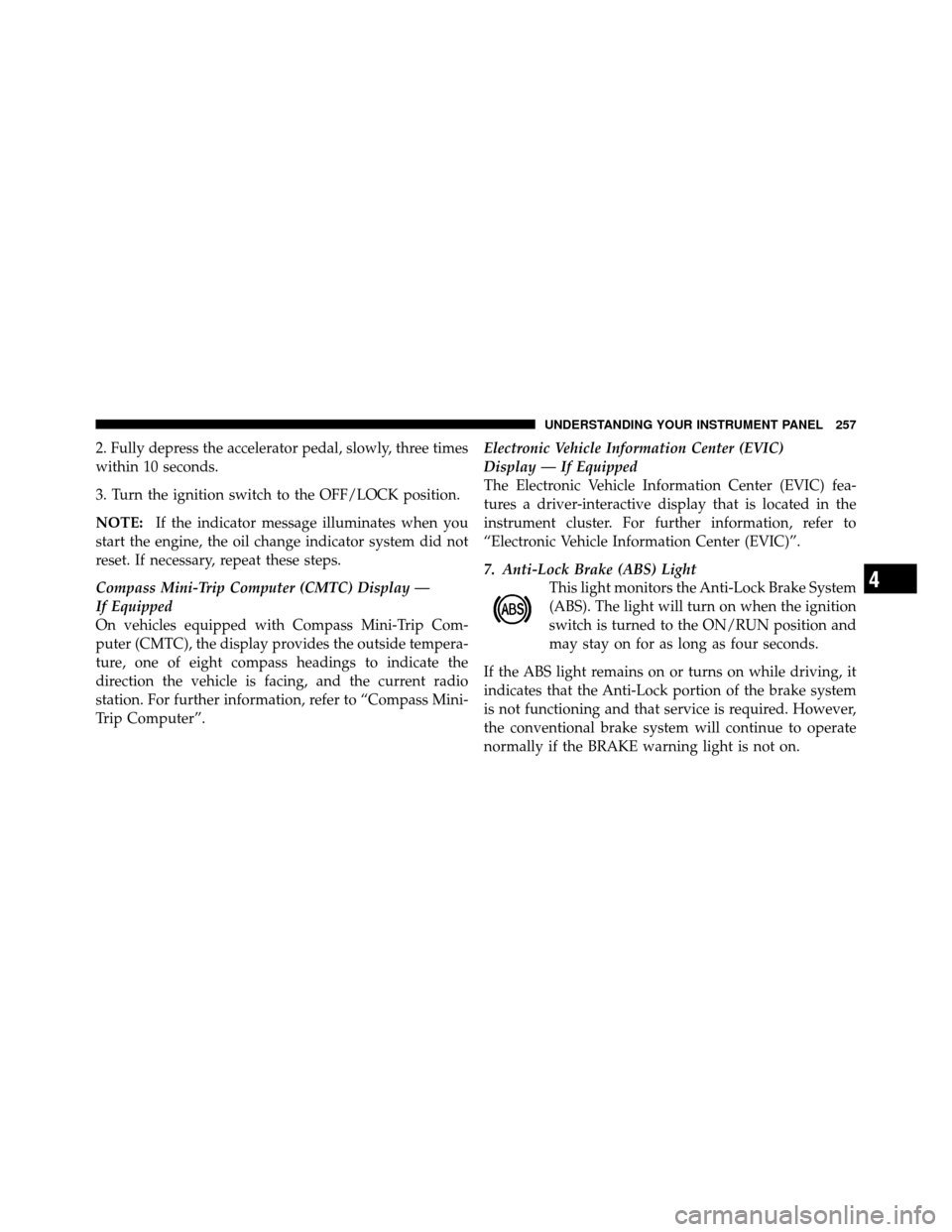
2. Fully depress the accelerator pedal, slowly, three times
within 10 seconds.
3. Turn the ignition switch to the OFF/LOCK position.
NOTE:If the indicator message illuminates when you
start the engine, the oil change indicator system did not
reset. If necessary, repeat these steps.
Compass Mini-Trip Computer (CMTC) Display —
If Equipped
On vehicles equipped with Compass Mini-Trip Com-
puter (CMTC), the display provides the outside tempera-
ture, one of eight compass headings to indicate the
direction the vehicle is facing, and the current radio
station. For further information, refer to “Compass Mini-
Trip Computer”. Electronic Vehicle Information Center (EVIC)
Display — If Equipped
The Electronic Vehicle Information Center (EVIC) fea-
tures a driver-interactive display that is located in the
instrument cluster. For further information, refer to
“Electronic Vehicle Information Center (EVIC)”.
7. Anti-Lock Brake (ABS) Light
This light monitors the Anti-Lock Brake System
(ABS). The light will turn on when the ignition
switch is turned to the ON/RUN position and
may stay on for as long as four seconds.
If the ABS light remains on or turns on while driving, it
indicates that the Anti-Lock portion of the brake system
is not functioning and that service is required. However,
the conventional brake system will continue to operate
normally if the BRAKE warning light is not on.
4
UNDERSTANDING YOUR INSTRUMENT PANEL 257
Page 270 of 573
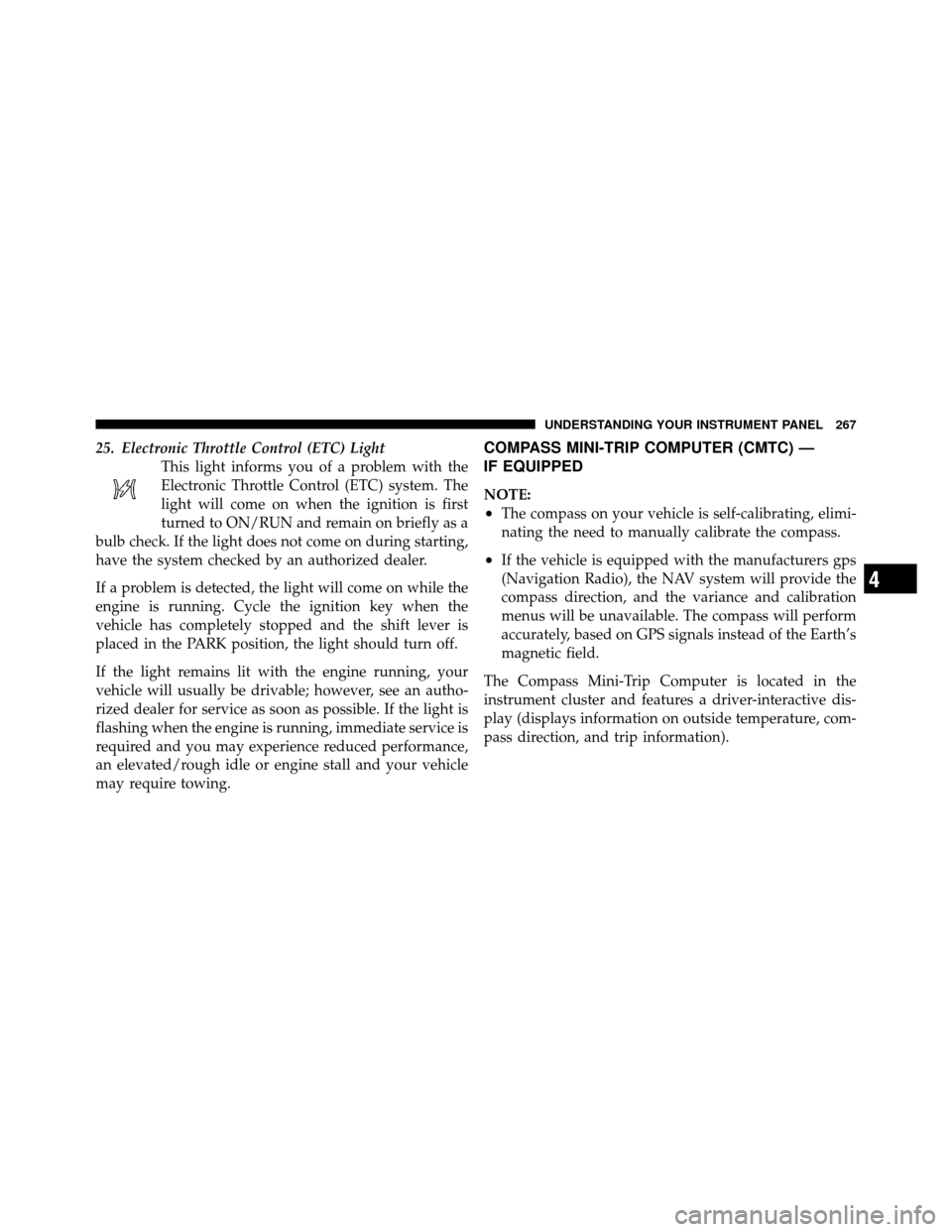
25. Electronic Throttle Control (ETC) LightThis light informs you of a problem with the
Electronic Throttle Control (ETC) system. The
light will come on when the ignition is first
turned to ON/RUN and remain on briefly as a
bulb check. If the light does not come on during starting,
have the system checked by an authorized dealer.
If a problem is detected, the light will come on while the
engine is running. Cycle the ignition key when the
vehicle has completely stopped and the shift lever is
placed in the PARK position, the light should turn off.
If the light remains lit with the engine running, your
vehicle will usually be drivable; however, see an autho-
rized dealer for service as soon as possible. If the light is
flashing when the engine is running, immediate service is
required and you may experience reduced performance,
an elevated/rough idle or engine stall and your vehicle
may require towing.COMPASS MINI-TRIP COMPUTER (CMTC) —
IF EQUIPPED
NOTE:
•The compass on your vehicle is self-calibrating, elimi-
nating the need to manually calibrate the compass.
•If the vehicle is equipped with the manufacturers gps
(Navigation Radio), the NAV system will provide the
compass direction, and the variance and calibration
menus will be unavailable. The compass will perform
accurately, based on GPS signals instead of the Earth’s
magnetic field.
The Compass Mini-Trip Computer is located in the
instrument cluster and features a driver-interactive dis-
play (displays information on outside temperature, com-
pass direction, and trip information).
4
UNDERSTANDING YOUR INSTRUMENT PANEL 267
Page 274 of 573
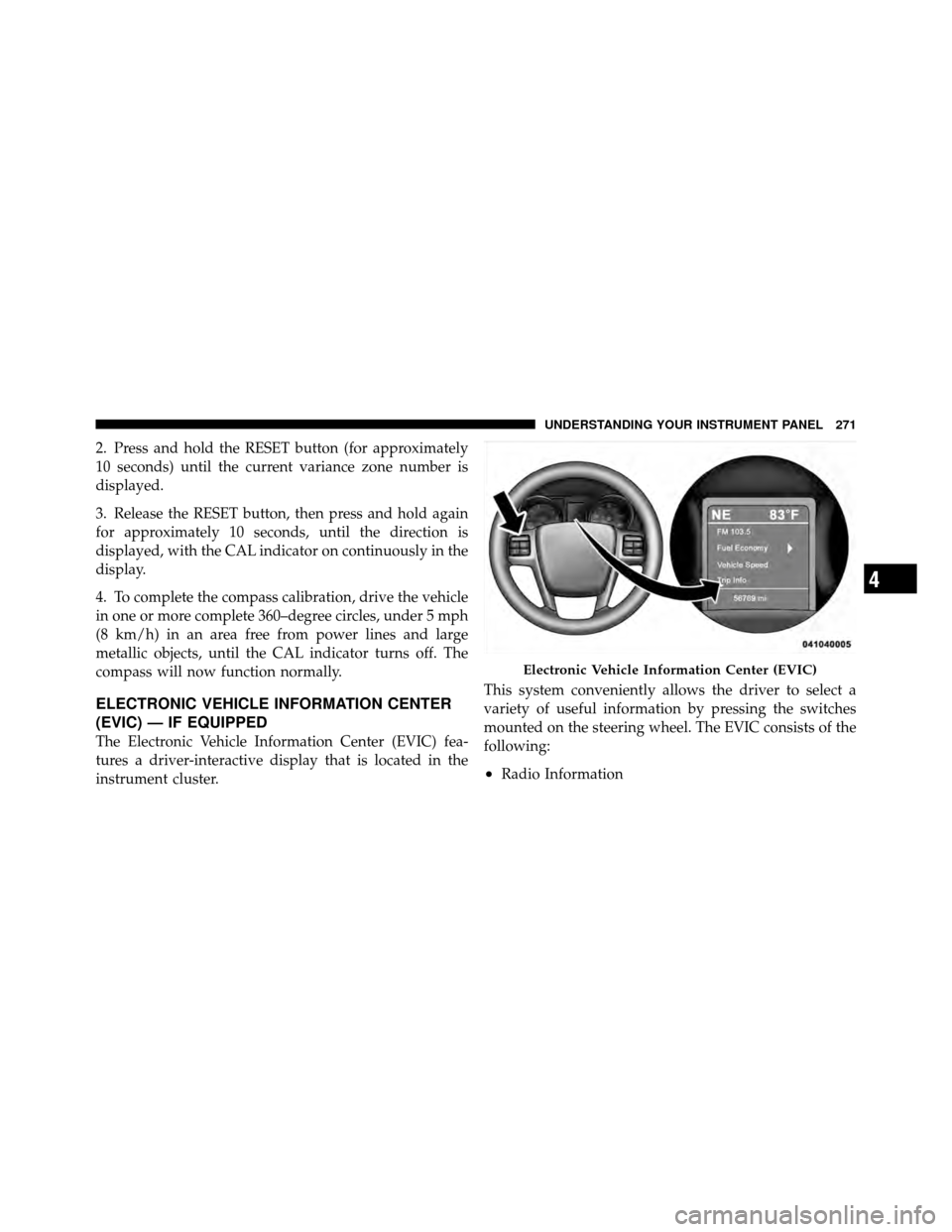
2. Press and hold the RESET button (for approximately
10 seconds) until the current variance zone number is
displayed.
3. Release the RESET button, then press and hold again
for approximately 10 seconds, until the direction is
displayed, with the CAL indicator on continuously in the
display.
4. To complete the compass calibration, drive the vehicle
in one or more complete 360–degree circles, under 5 mph
(8 km/h) in an area free from power lines and large
metallic objects, until the CAL indicator turns off. The
compass will now function normally.
ELECTRONIC VEHICLE INFORMATION CENTER
(EVIC) — IF EQUIPPED
The Electronic Vehicle Information Center (EVIC) fea-
tures a driver-interactive display that is located in the
instrument cluster.This system conveniently allows the driver to select a
variety of useful information by pressing the switches
mounted on the steering wheel. The EVIC consists of the
following:
•Radio Information
Electronic Vehicle Information Center (EVIC)
4
UNDERSTANDING YOUR INSTRUMENT PANEL 271